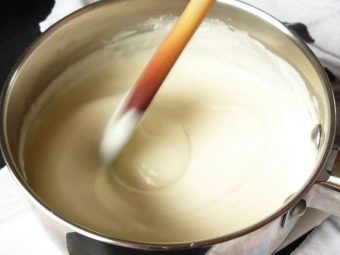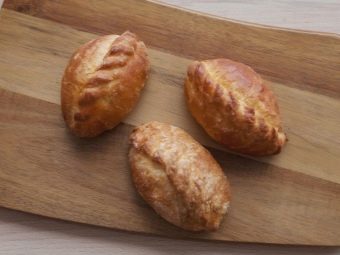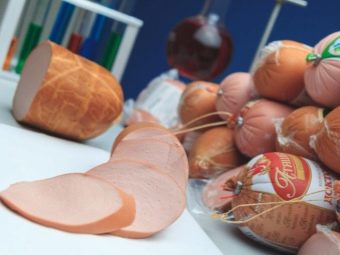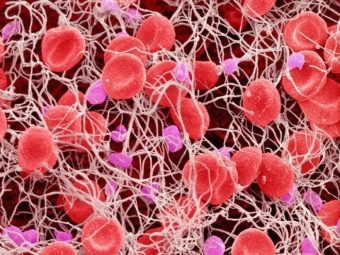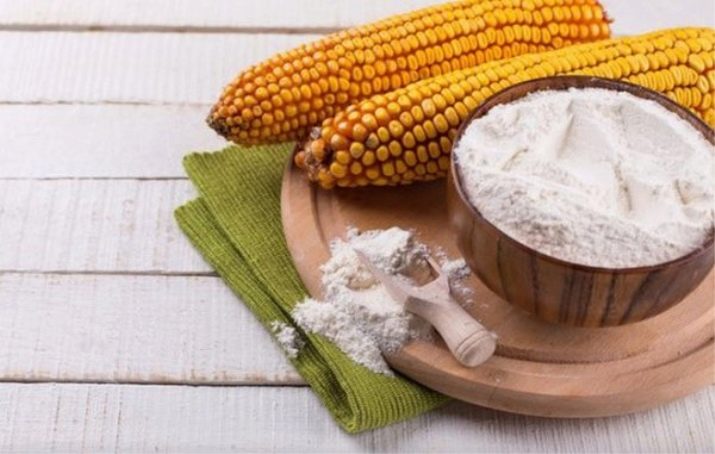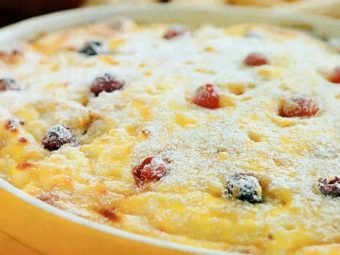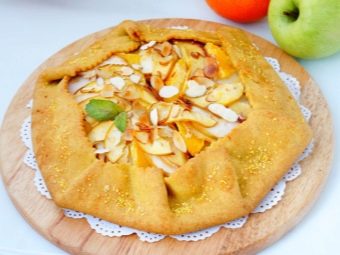Corn Starch: composition, properties, and scope
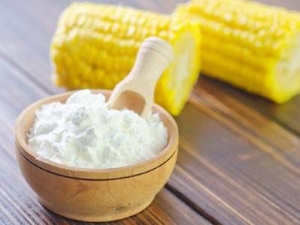
Corn starch has a number of useful properties.Its presence is invisible in products, it is transparent and effective as a thickener. As a baking powder starch is actively used in the food industry and the preparation of homemade dishes. With many useful properties, this product is also used in the cosmetic industry and pharmacology. Indispensable cornstarch in the manufacture of fabrics and paper.
What is it?
Corn starch is functional and is used extensively in the food industry, the cosmetic industry, and the preparation of homemade dishes. The color of the starch is translucent or whitish, when impregnated with water, the substance is able to quickly increase in volume.
Cooking flour and starch have different principles. Flour is obtained as a result of mechanical grinding of maize grains.
As for starch, it is produced in another way. Starch is obtained by soaking the corn in sulfuric acid. As a result of coarse grinding, the product grains are separated, with fine grinding, the starch is separated from the fiber. Then the product is repeatedly cleaned using a centrifuge.
After cleaning occurs, the corn is soaked in hot water for at least 5 hours. In fact, this process can be called controlled fermentation, in which sulfur oxide is added. All these tricks give a positive result: harmful bacteria are killed, fungal spores, and the growth of beneficial microorganisms is stimulated. After passing soaking the grains are tripled. After this, excess water is removed by evaporation and centrifuge processing.
Kohler starch is sometimes different from the usual, may have a dark yellow color.
This product is nutritious and healthy, it has a huge number of different trace elements and fatty acids. Starch contributes to the normalization of metabolism, strengthens the nervous system, activates the work of the brain and heart.
The molecular structures of corn and potato starches differ markedly. The mixture of the latter is thicker and sticky. The cost of corn starch is lower (up to one hundred rubles per kilogram), its use in industry, from an economic point of view, is more than justified. Manufacturers actively use this product, adding it to various products. This practice is especially widespread in the United States, where long-term programs to reduce the cost of products are adopted at the official level.
As well as corn starch can often be found in the production of plastic bags and PVC film.
What is a modified starch?
The modified starch is in no way associated with GMOs, there are no cells in the starch, so a priori it cannot be modified at the gene level. The word "modified" means "modified", that is, the substance was subjected to a certain processing, as a result of which there was a change in its qualities. In total, according to GOST, at least two dozen types of corn starch are used. Each of them has its own performance characteristics, used in various technological cycles.
First of all, when processing starch, the characteristic odor is eliminated; this should be done if the raw material “works” in the cosmetic or food industry.
Often, the starch is necessary to change the color, especially such a need arises if the substance is used for technical purposes. Starch is also used in bulk products, then they acquire higher qualities, become more plastic, and there is no significant clumping in them.
Often, corn starch is used in the production of various powders (including for babies), bakers also actively use it in their work.
In the food industry, starch is most often found in such products:
- ketchup;
- confectionery;
- bread.
Corn starch can be a natural and effective flavor enhancer, therefore, it is most often present in bakery products.In the manufacture of sausages and sausages starch is used in permanent mode, this product is less worth than soybeans, not to mention meat. Baby food uses a special starch, which has been thoroughly cleaned in special aggregates.
What is useful?
Starch is not dangerous to the human body. The product should nonetheless be consumed in reasonable quantities. The substance consists of complex carbohydrate compounds, Therefore, in diabetes, the benefits of corn starch are significant, it is part of many diets.
The decomposition of the product takes a long time, so the blood sugar level practically does not increase. Starch is necessary and useful for patients suffering from:
- cardiovascular diseases;
- diseases of the genitourinary system;
- diseases of the liver and pancreas;
- digestive tract.
Starch composition is almost identical to corn flour, so these two products are interchangeable. The technology for producing flour is simpler, it does not go through a complex processing cycle. As a result of its use, a cloudy, darkish precipitate can often be observed. Often used to make a variety of sauces.
Carbohydrates are split quite slowly, it gives a noticeable decrease in the rate of sugar generation. Very good starch acts on the resistant properties of the immune system, promotes the accumulation of muscle mass, stops various infectious inflammatory processes. Positive effect on neurons, which contributes to the removal of mental fatigue and depressed state.
Use the product is recommended for patients suffering from anemia, as well as hypertension. There is no gluten in the starch, so it is ideal for preparing various dishes for patients with diabetes.
Tapioca starch can also be an analogue of such a product; gluten is also completely absent in it. One of the common varieties of corn starch is amylopectin starch, it has an artificial origin, but its indicators in terms of thickening and transparency are much lower.
The benefits of using cornstarch:
- removes toxins and slags;
- prevents excessive blood clotting;
- is a diuretic;
- has anti-inflammatory effect;
- stimulates appetite;
- used as a means to reduce weight;
- improves skin condition.
In type 2 diabetes, corn starch is particularly useful to use, it prevents glucose from being absorbed into the blood for a long time. It should be remembered that starch does not cause fluctuations in glycemia only if its amount does not exceed 18-20%.
Harm
There are a number of diseases in which this product is not recommended.
If starch is used in large quantities, the metabolism slows down markedly. But also often there is a lack of moisture in the body.
The product can be harmful to people who have high blood clotting, they should refrain from taking this product. Excessive use of corn starch is contraindicated in patients suffering from intestinal and stomach diseases, it is useful to use it only in small quantities. For patients with diabetes, the use of the product is not more than 160 grams per knock.
Calorie and nutritional value
In accordance with GOST, corn flour has the following composition:
- water - 15%;
- acid - 21-26 cm3;
- protein - 0.9-1%;
- the presence of SO2 - 52 mg / kg.
And also in the starch there are various trace elements: selenium, manganese, phosphorus and many others. The calorie content of the product is 380 kcal, which is 25% of the normal level.
Per 100 grams of product accounts for:
- protein - 0.31 g, 0.38%;
- fats - 0.11 g, 0.16%;
- carbohydrates - 91.2 g, 71.35%;
- dietary fiber - 0.91 g, 4.6%;
- water - 8.32 g, 0.33%.
The glycemic index (GI) is an indicator that indicates the sugar content after a product has been eaten.GI level is actually an indicator of sugar level, which indicates how much carbohydrate from the body can be absorbed. A similar parameter can be present only in food that contains carbohydrates, where there are proteins and fats. They are assimilated gradually, so a sharp drop in the level of sugar is not observed.
Corn starch has an optimal level of GI, so it is recommended for diabetics.
BJU - proportionality of proteins and carbohydrates (1: 303). Protein contains only 0.31 units, no gluten. There are many amino acids, as well as complex protein compounds.
Where is it used?
On the packaging of this product is designated E1422. Corn starch is often used for homemade dishes. For example, when preparing a jelly for thickening, the product has a natural origin, it can not cause any side effects. This product is suitable for diabetics, it is part of many dishes of people who think about losing weight and losing weight. From it you can cook a lot of dietary dishes.
In cooking
In this area, the product effectively "works" as a thickener. After dissolving the substance in water, it is heated and then allowed to cool, after which the mixture becomes gel-like. In its TTX, the corn product is inferior to potato starch, yet it is often used in the preparation of homemade dishes and various branches of production.
The product has a particularly delicate gluten, so it is perfect for cooking at home:
- fillings for cakes;
- thickener for sauces and puddings;
- when cooking first courses;
- yogurts;
- sweets and cakes;
- preparation of the test.
When used in baking, corn starch can make the product crumbly, juicy, delicate in taste. The product is actively used in the meat and dairy industry and the manufacture of baby food, where corn starch is used as an absorbent.
In cosmetology
Starch has a beneficial effect on the skin, it is often used in the manufacture of various compresses used for facial rejuvenation, renewal of the epidermis.
It is important to immediately understand that the body does not have allergic reactions to this composition. But also there should not be any scratches on the skin or abrasions. Here are some basic recipes for face masks.
The botox effect is done as follows:
- tablespoon composition;
- half a tablespoon of olive oil;
- crushed tomato (small).
The mask is applied in a thin layer on the skin and held for a quarter of an hour, then washed off with warm water.
Wrinkle smoothing:
- warm milk 2 tablespoons;
- one teaspoon of honey;
- a small pinch of salt.
After the sauna is applied with a thin layer on the face, when the mask dries, the second layer is applied. Aged for a quarter of an hour and washed off with warm water.
Pimple remedy:
- boiled milk - 2 tablespoons;
- cereals;
- addition of a teaspoon of honey;
- a pinch of salt;
- corn starch - 2 tsp.
Apply on the skin, rubbed with a thin layer, after twenty minutes, the composition can be washed off with warm water.
Corn starch helps to get rid of black spots on the face, it also reduces the fat content of the skin:
- egg white, egg - 1 pc .;
- two tablespoons of the composition;
- tea tree oil - 1 tsp.
Mix is stirred and pounded by such layer. The mask is aged for twenty minutes.
Skin elasticity:
- a glass of cream;
- 2 tablespoons of the composition;
- mashed potatoes made from crushed banana.
The mixture is thoroughly mixed and applied with a thin layer. 12 minutes is enough for the composition to be absorbed into the pores of the skin. Then the mask is gently rinsed with warm water.
In medicine
In the people the product is often used as a medicine, it can effectively reduce pressure.
At 200 g of water should dissolve 15 g of starch, in the morning drink on an empty stomach. Repeat the operation throughout the crescent. The product stimulates the digestive tract, as well as the pancreas.For 200 g of hot water, add one tablespoon of starch, a couple of drops of iodine. Carefully stirred and drunk.
When gallbladder dysfunction during the week is taken three times in 24 hours. A half cup of water dissolves 30 grams of the product.
You can also make compresses against bruises and abrasions. Two teaspoons of starch are added to one tablespoon of water. Superimposed overnight in the form of a compress. If the wound is deep, repeat the procedure several times.
In the textile industry
Corn starch is most commonly used in the manufacture of paper and fabrics. And also the last decades the product is involved in the manufacture of plastics. Starch is an effective thickener, it is inexpensive, and it is actively used in the textile industry. The threads are passed through the solution (dressing), which makes it more durable. After that it can be used in weaving. The so-called sizing cycle consists of two phases:
- gluing of threads (wetting and impregnation);
- spinning and drying.
The grain size of the product is 15.2 microns, it is actively used in the manufacture of dressings. It has the following advantages:
- well gets wet;
- forms a strong film;
- has a low viscosity coefficient;
- is inexpensive;
- It has excellent quality.
Sometimes corn starch is not suitable for the manufacture of some fabrics, as it has a rather high coefficient of hardness.
For information on the composition, properties and scope of the corn temple, see the following video.

